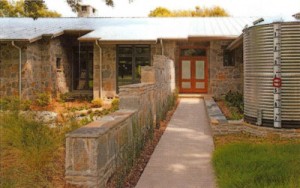Shades of Green

This Texas regional modern home is reminiscent of a great old farmhouse. Exposed beams and an old dining room table add to the aurora. Below: Lulu plays on the floor made of pine blocks.
Two similar houses sit on two very different yards in Preston Hollow. Both were built green. Both are considered Texas regional modern. Both slow down water runoff, use durable flooring, and have Rumford fireplaces.But the similarities stop there. Although both homes were designed by architect Stephen Chambers, they are as different as night and day.
But they both are perfect matches with their homeowners.
“I think they have a completely different feel,” Chambers said. “I think they’re both really… appropriate for the client.”
For Susan Hawkins and her husband Ralph, CEO of the HKS architecture firm, it was important to build a home that provided a better future. But they also wanted a home that would meet all their needs.
Although a basic idea of green building is to reuse, the Hawkins said the lot’s previous home just could not be saved. But one of the reasons they bought the land was for the large, mature trees. The Hawkins wanted to save as many as possible, so they built their home in the same footsteps as the previous structure. And although xeriscaping is expected of green homes, the Hawkins’ front and backyards are full of lush grass and plants. But the yard is designed to keep water from running off quickly.

A collaboration between Chambers Architects and HKS, Inc.; schematic design by Ralph Hawkins, FAIA, HKS, Inc.
“Part of the idea with sustainable design is [to] not do things that overtax the infrastructure of the city,” Chambers said. “If we can let the water run off the site, but not let it run off as fast as it would if it were paved, then we’re saving the city of Dallas from having to improve their infrastructure.” And then there’s the fireplace. “Let me tell you, that’s not completely sustainable,” said Ralph Hawkins, who has his LEED certification.
The floors in the house are made of bamboo, boiled for a deeper color. The wall separating the formal area from the living areas is made of stones found in the panhandle of Texas. And the house is all about the natural lighting.
 The couple thought perhaps the house could be LEED certified. The commission agent said they’d have to change a few things first — including sealing up the fireplace. The couple decided they didn’t need certification. They liked their house as it was: with a good mix of green elements and a few non-green items. Their electric bill is less than $50 a month for the 6,800-square-foot house, and the home is their oasis.
The couple thought perhaps the house could be LEED certified. The commission agent said they’d have to change a few things first — including sealing up the fireplace. The couple decided they didn’t need certification. They liked their house as it was: with a good mix of green elements and a few non-green items. Their electric bill is less than $50 a month for the 6,800-square-foot house, and the home is their oasis.
Chambers said the Hawkinses chose their own shade of green, which is how most of his clients build.
“That is something about the green or sustainable design — not everybody sees it the same way,” Chambers said. “Certain people have certain priorities. It’s not an ‘everything or nothing’ idea…. Even if you do a house that can be certified with one program or another, the fact that you use most or any of the ideas is really going to help us.”
(If you want to find out more about his house, visit the case study.)
Across Inwood Road, a 1,650-gallon galvanized steel cistern and a pond greet guests as they enter a more traditional Texas regional modern home.
“At Ralph’s house, we took the topography and slowed the runoff of the water and made more water be absorbed,” said Chambers, who was also an architect for the second home. “We did the same thing [here], but in this case, it fills the tank instead of running off the topography.”
“It’s just the basic way of doing good design, just a thoughtful type of design,” he said.
Even though this good design has the same basic principles, its application can obviously have completely different results, as showcased by these two houses that share the same architect.
For the interior of the house, the homeowners decided to use pine blocks. Pine, a fast growing, renewable resource, creates a gorgeous design on the floor. Although the open-cell foam insulation, high-efficiency appliances, and low-flow plumbing all speak to the homeowners’ interest in maintaining a sustainable design, one of the most important features is the front lawn. Complete with a rain chain, the xeriscaped yard has been deemed a National Wildlife Federation habitat. Frogs, ducks, and rare dragonflies call this structure their home. And there’s no need for a lawn mower: The Zoysia grass gets no higher than a few inches. This house is vastly different from its neighbor.
See the portfolio of this house.
“It’s so much fun working on two totally different houses and getting two totally different looks,” Chambers said.
Sustainable design has become vogue the last few years, and both sets of homeowners said it’s something they plan on passing on. For Chambers, building green is nothing new; it’s just good design.


